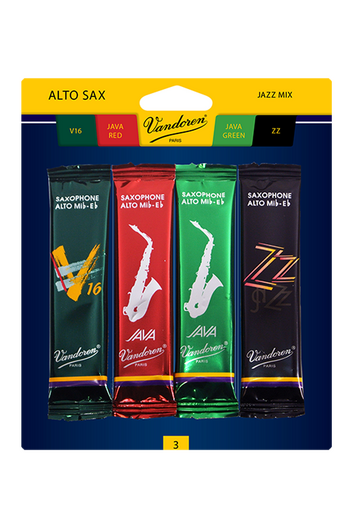Jazz Reeds: How They Can Transform Your Sound
A comprehensive interview with Dr. Michael Fenoglio
Date Posted: February 22, 2017

Interview conducted by John R. Hylkema, Updated July 28, 2020
What is the benefit of playing on a jazz reed as opposed to a more "classical" reed?
Michael Fenoglio: Your sound is everything, and finding the right reed is a very personal choice. There are many different styles meant to provide the player with nuance in regard to tone and response. Generally speaking, jazz reeds are designed to provide players with more edge and projection. This helps players and sax sections cut through brass and rhythm sections in a jazz band or amplified instruments in a rock band, for instance.
From a construction perspective, how does a jazz reed differ from a classical reed?
MF: Compared to reeds designed for classical playing, jazz reeds typically have a slightly thicker tip and thinner heart. This is what allows more of the upper overtones to sneak in giving your sound more edge and projection. You might hear people refer to this as a brighter sound. On the flip side, the thicker heart and thinner tip of a classical reed provides players with a darker sound with quick and precise articulation.

For a performer, how does a jazz reed play differently than a classical reed?
MF: If you asked 10 players this question you might get 10 different answers. But for me, they help me get the sound that I have cultivated in my mind after years of listening and practicing. I enjoy the more explosive response, flexibility, and color variations that jazz reeds provide. In terms of response and feel, I tend to tongue harder and use more forceful air when playing jazz, and the thicker tip of a jazz reed tends to hold up better for me over time and gives me a full, “meaty” articulation. Regarding sound, I find that with the right jazz reed I can easily cover the tonal spectrum of brightness to darkness in the moment – which I find absolutely essential in effective jazz performance. For me personally, while classical reeds provide the clarity and uniformity that are necessary for a concert or recital hall, they do not offer me this same type tonal flexibility.
"All Vandoren jazz reeds have something different to offer, giving players a wide variety of great options to choose from." - Dr. Michael Fenoglio
As a listener, what differences will someone hear when a performer uses a jazz reed as opposed to a classical reed?
MF: It all depends on the mouthpiece and reed combination and also the player themselves. But I find that if I use the same mouthpiece and only change reeds, a classical reed gives my sound slightly more focus, warmth, and precise articulation, whereas with the jazz reed my sound is slightly more spread with more upper overtones and “buzz.”
Is there anything different that needs to be done when breaking in, maintaining, and storing a jazz reed?
MF: It’s always a good idea to break in a reed gradually over the course of a week or so. Classical players are usually great at this. However, speaking from experience, most jazz players are not. We tend to like playing reeds right out of the box. So with this in mind, at the very least I would encourage people to find a few different reeds to rotate from day to day. This way your embouchure stays in shape and your reeds will last quite a bit longer. If you only play on one reed until it dies, your embouchure weakens along with the reed. This means that the next reed out of the box will feel much harder, and maybe even unplayable. How you store reeds also makes a difference. So many people just leave their "go-to" reed on the mouthpiece around the clock. First of all...that's disgusting and super unhealthy! Second of all, this will drastically reduce the life span of your reed and increase warping. So at the very least, find a few reeds to rotate from day to day, and find a good case to store them in. Your doctor, embouchure, and wallet will thank you later!
What is something unique about each of the four jazz reeds offered by Vandoren?
MF: All Vandoren jazz reeds have something different to offer, giving players a wide variety of great options to choose from. That said we all have our favorites, and lately I’ve been really in to ZZs and V16s. I find they pair really well with my V16 A5M and A5S+mouthpieces.
For me, the ZZ is middle of the road in terms of brightness and darkness, but still has plenty of zip. These qualities allow me to shape my sound in a variety of ways.
The V16 plays a little harder and consequently a little darker for me. Both are really easy to control and help me get that fat alto sound that I’m always hearing in my head. I mix and match depending on the day or gig.
I also know a lot of people that love the JAVA Green and JAVA Red reeds. Most people find these reeds to be a bit brighter and maybe just a shade more flexible.
For me the JAVA Green is the brightest, with really quick response and great flexibility.
I like to think of the JAVA Red as the powerhouse Vandoren reed. Once you find the right strength it gives you the ultimate projection and edge. I really like these reeds for rock or Latin style music, but I know plenty of people that use them for straight ahead jazz too.
Like I've said before, finding your own sound as a jazz musician is such a personal endeavor. Everything I’ve mentioned above reflects my own experience. Having four different reeds to choose from that are specifically designed for jazz is a real luxury. With that in mind, I highly encourage players to try them all out and draw their own conclusions.

About the Author
Dr. Michael Fenoglio is a saxophonist, composer, and music educator residing in central Illinois. He earned his DMA in Jazz Saxophone Performance from University of Illinois where he studied and taught under professors Chip McNeill and Debra Richtmeyer. Michael has performed with a variety of renowned artists including The Temptations, The Doc Severinsen Big Band, Ira Sullivan, and Phil Woods. His most recent projects include his band's self-titled album "The Old Style Sextet" on BluJazz Records, and guitarist Chris Beyt's "120."
As a member of the Vandoren marketing team, Michael plays an active role in the VAC program, product training, ads and promotion, content creation, and trade shows. Outside of music Michael also enjoys cooking, gardening, and hassling all of the Cardinal fans at the office. Go Cubs!